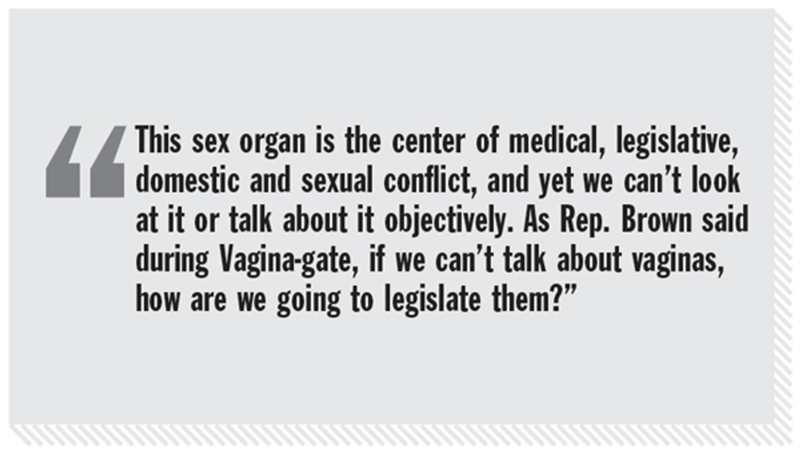The vagina: About half of Americans have one and a good deal more Americans than that actually came out of one.
In 1919, it — or more specifically, the women connected to it — got the right to vote with the passage of the 19th Amendment; in 1973, it got some say over who controls it with the decision of Roe v. Wade; and in 1996, in the basement of a Greenwich Village café, it got a voice when Eve Ensler opened The Vagina Monologues.
But during last year’s elections, the “legitimacy” of its rape was called into question; in June 2012, Democratic Michigan state representative Lisa Brown was banned from the floor after saying it during an anti-abortion bill debate; and during a recent episode of The Mindy Project on FOX included a joke about how you aren’t allowed to say it on the news, even if you’re doing a segment on women’s gynecological health. (In fact, during the 2010-2011 television season, the word “vagina” was only used 35 times in shows on network channels.)
This sex organ is the center of medical, legislative, domestic and sexual conflict, and yet we can’t look at it or talk about it objectively. As Rep. Brown said during Vagina-gate, if we can’t talk about vaginas, how are we going to legislate them? That jarring reality is what Kate Elliott and Blake Plowden are attempting to call attention to with Re-Envisioning the Female Body, their large-scale, two-day exhibit and demonstration on the University of Cincinnati campus.
The exhibit — made up of 11 4-by-6-foot photographic billboards of vaginas, 15 smaller signs featuring personal quotes about the female experience via the vagina and one large billboard with a quote about race and the vagina — is a commentary on the sale and suppression of women’s sexuality in advertising and media and on how a woman’s body fits into medicine and healthcare.
The initial idea for the exhibit sprang from Elliott’s visceral response to the presence of the Genocide Awareness Project on UC’s campus in May 2012. The GAP, a traveling pro-life, oversized photo display, juxtaposes images of Holocaust victims next to images of similarly posed mutilated, late-term abortions, effectively comparing reproductive rights to genocide.
“I was really upset by it and that’s when the wheels started turning,” Elliott says. “I was thinking about why is it that violence is not censored in our daily discourse — we’re allowed to see and talk and hear about violence — but certain things like sex and especially the woman’s body [are] censored.”
This exhibit’s billboards, whose production, along with the rest of the demonstration, was funded through club resources via UC Alliance, a campus LGBTQ group, and approved by the University Funding Board, show images of vaginas in an almost gynecological perspective, with legs spread, as if in stirrups. Some are shaved, some are blemished, some have tampons inside.
“The pose that I chose reflects this idea that a woman’s body is sort of medicalized,” says Elliott, who took all of the photographs. “I overexposed the images so they’re really jarring. They’re not cutesy or subtle, they’re right up in your face.”
The photos call into question our culture’s perception of what constitutes art, what constitutes obscenity and incites critical conversation on how images enter our shared spaces. The billboards take on further meaning when interrupted by narrative placards, forcefully inserting women’s voices — some from the models, some not — where they may have been previously absent.
Voices in the demonstrations include a women’s activist passionate about the empowerment of natural birth, who wanted to model to show what a healed post-birth vagina looks like to create a space for recognition — without digital manipulation or airbrushing – and reclamation; a quote from a virgin who masturbates, which questions “what sex is and what makes you sexually active,” says Elliott; a quote from a trans-man, who found a love for his body as a sex worker after a lifetime of trauma and sexual abuse; and the story of a woman who chose to have an abortion at 16.
Elliott notes that while she believes she did a good job representing these women’s voices, she knows the demonstration is not complete.
“I know that the demonstration lacks a certain amount of representation and I recognize that,” says Elliott, who added a billboard-sized quote from a friend who expressed how this exhibit did not encapsulate her experience with her vagina as a black woman. “I wanted to recognize that I’m not going to deny or push aside [people’s feelings] to try to make this sort of uniform collective … I wanted it to be messy because our experiences as women are very messy, they’re not tailored, they’re not neat, they’re not uniform and there are women who don’t identify with what we’re doing and I wanted to show that.”
RE-ENVISIONING THE FEMALE BODY
is on display 11 a.m.-3 p.m. Thursday and Friday (International Women’s Day) on McMicken Commons at the University of Cincinnati with a kick-off panel discussion, hosted by Planned Parenthood, at 7 p.m. Wednesday.


